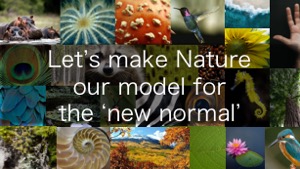There has been a lot of discussion about the ‘new normal’, referring to the way the world will work when the pandemic loosens its grip and protests begin to subside and turn into problem-solving. Those of us working for social and environmental sustainability and justice hope that our recent massive disruptions are an opportunity to make real and lasting change.
With this in mind, the Amani Institute has been offering, for free, a 4-month journey called Visions for Change. My small contribution to this program was an online Skill Pills workshop exploring how biomimicry can help us design better services, products, and organizations for the ‘new normal’.
We focused on how Nature deals with disruption by designing for resilience; however, the first, and perhaps most important, point we explored is that the ‘old normal’ is not normal!
It is not normal to create massive craters in the Earth to obtain the materials we need to generate the goods that we want.
It is not normal to desecrate entire landscapes and spew pollutants into the air and water to generate the energy that we want.
It is not normal to make plastics that never decompose and then toss them into our rivers and bays and oceans when we are done with them.
It is not normal to depend on highly toxic chemicals to achieve our design objectives and economic goals.
It is not normal to exploit peoples and places to obtain required but limited resources, causing endless conflicts and refugees.
It is not normal for the affluent to raise children to be consumers, so that they prefer to play with devices indoors rather than each other outdoors.
It is not normal for our leading economic indicators to go up while infection and death rates continue to rise.
So the old normal is not normal — not all all.
What is normal? Nature is normal. It always has been and always will be.
It is normal to use resources that are locally available and abundant.
It is normal to create beautiful landscapes and clean the air and water while collecting and distributing energy.
It is normal to make materials that can decompose and, in doing so, provide shelter and food, and build the soil.
It is normal to manufacture using only life-friendly processes, often creating opportunities for others in the process.
It is normal to use resources that are abundant and locally available.
It is normal to pay attention to metrics that measure what is really important, we really value.
As we begin to emerge from our current disruption and plan for the future, please let’s make Nature our model for the ‘new normal’.
If you’re interested in how to design for the new normal using Nature as your model, please explore our fully online MA in Sustainable Design degree.

